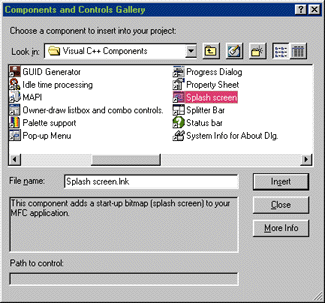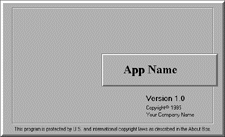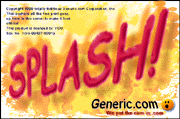October 1999
![]()

|
Code for this article: Oct99CQ&A.exe (309KB) Paul DiLascia is the author of Windows ++: Writing Reusable Code in C++ (Addison-Wesley, 1992) and a freelance consultant and writer-at-large. He can be reached at askpd@pobox.com or http://pobox.com/~askpd.
|
|
Q How can I implement a start-up screen that displays a bitmap in MFC?
Turner Munbrey
A The Visual C++® Component Gallery has a component called Splash screen (see Figure 1). Just open the Components window, select Splash screen, and press Insert. Visual C++ adds a new module (splash.h and splash.cpp) to your project, and some lines of code to your app and CMainFrame classes. You even get a blank bitmap like the one in Figure 2. |
 |
| Figure 1: Adding a Splash Screen |
|
The vanilla splash is nice, but it's not very satisfying. Aside from the glum bitmap, it adds code to your app in several places. There's a CWinApp::PreTranslateMessage override to let the splash process messages, some lines to your InitInstance function to parse command line args, and a line in your CMainFrame to show the splash when your app starts up. A line here, a line there, three lines somewhere else—why all this spaghetti code when it's totally unnecessary? But that's the problem with code generators—they generate code. In just a moment, I'll show you how to write a splash screen you can install with one line of code. But first let me mention two more significant problems with the prepackaged splash screen. Problem number one: the splash appears for a fixed number of seconds that you specify—two, say—and then disappears. But often the reason you want a splash screen is to give your users something to look at while your app takes forever to start up. While the splash is running, your app is scrambling to get itself in gear. But if your app is computing—loading a file or initializing some humongoid list structure with ten bazillion items, say—it can't process messages through its main message pump. The component gallery generates a splash window that runs in the same process and thread as the main app, which means it doesn't get messages while your app is chomping at the CPU. If the user clicks to dismiss the splash, nothing happens. Nor will the splash get any timer messages. |
 |
| Figure 2: Scintillating Splash |
|
Problem number two: the splash screen you get from Redmond uses CBitmap and BitBlt to display its bitmap—which is to say it doesn't do palette realization. That's fine for the melancholic black-and-gray splash in Figure 2, but if your splash has lots of exotic cheery colors, it'll look pathetic in 256 color mode. Of course, nowadays even your grandmother has a 32MB video card, but I'm told some people still use 256 color mode to get more pixels. They must be deranged—but who listens to me? Needless to say, I wrote my own CSplash class to fix all these inadequacies. What else am I here for? To use CSplash, all you have to do (aside from adding the files to your project and #including the header) is add the promised one-liner to your app's InitInstance function: That's it; that's all there is. Just create the splash and forget about it. You don't even have to delete it since CSplash manages its own death. This is the way life should be. No code generators, just import the thing and call it. If for some reason you want to kill your splash prematurely (perhaps you're feeling aggressive today), there's a way to do it: Using CSplash is a stroll in the park, so now let's go inside the code to see how I pulled all those rabbits out my hat. Actually, it's pretty straightforward. First, CSplash is derived from CWinThread, which is to say, a splash is a thread. When you create a new CSplash, the constructor saves its arguments and calls CreateThread (which CSplash inherits from CWinThread) to create a new user interface thread. Control returns immediately to your app, which can hoard the CPU all it likes while—poof!—the splash disappears through a wormhole. And—poof!—the splash pops out the other side, over here in the gamma quadrant, which is to say, in a new thread. As the thread starts up, MFC goes through its usual initialization conniptions before eventually calling the thread's InitInstance function. CSplash::InitInstance parses the main app's command line to check for -Embedding (embedded OLE object), -Automation (automation server), or -nologo. If any of these are present, InitInstance returns FALSE to terminate the thread; otherwise, it creates the splash window. I forgot to mention the flags. When you create a CSplash, you give it flags. Every API has to have some flags. Currently, there are only three: CSplash::KillOnClick tells the splash to do the dismiss-if-the-user-presses-a-key thing; IgnoreCmdLine tells the splash to splash, even if the command line says -nologo (I only added this for my test program); and CSplash::NoWaitForMainWnd presents the wait-for-main-window feature. Aside from all that, window creation is totally normal. CSplash::OnCreateSplashWnd calls CSplashWnd::Create, which loads the bitmap and calls CreateEx. To handle DIBs correctly, I (re)used the CDib class from my MFC Goodies articles in the January and March 1997 issues of MSJ. Using CDib, loading the bitmap is as simple as this: So far, CSplashWnd is pretty straightforward. I've saved the tricky part for last. Terminating a user interface thread—that is, a thread that displays a window—is always a little delicate. In this case, it can happen in one of three ways: the timer pops, the user clicks or types at the splash, or the app calls CSplash::Kill. In the first case (timer pop), CSplashWnd checks to see whether the app has a main window. If not, it sets another timer to wait another tenth of a second. The last way the thread can die is if the main process calls CSplash::Kill. In this case, CSplash posts WM_CLOSE: And so the story ends. Figure 3 shows the final code. By implementing CSplash the way I've shown, all the code is self-contained. There's no need to hook into the message loop or any other bizarreness. Just create the splash when your app starts up and forget about it. Whenever you add new functionality to your app, you should always strive for the narrowest interface possible—that is, the one with the fewest calls and interactions. Your code is much more likely to work that way. With CSplash, the only real work you have to do is the fun part: namely, create a bitmap that looks splashy. Figure 4 shows my test splash. But don't get too carried away! Visual Studio spends so many CPU cycles displaying its splash screen that it's noticeably faster starting up if you add -nologo to the command string in your registry. |
 |
| Figure 4: Splashy Splash |
|
Q How can I parse the command line in an MFC app? My program has several command line options (such as -l, -x,
-help). I see there's m_lpCmdLine that points to the command line, but do I have to parse it myself? It seems like there should be some way to make CCommandLineInfo do it, but I can't figure out how.
Amy Brechstler
A You're on the right track. CCommandLineInfo is the class MFC uses to parse command-line options; the generic MFC app starts out with the following lines in InitInstance:
CCommandLineInfo is all very fine and dandy, but there's no easy provision to add your own options, other than to derive a new class and override ParseParam. That's a lot of typing for such a simple feature. What you really want is to call some function that will get the value of any options the user may have typed. How does CCommandLineInfoEx work? Simple. It uses a string hash (CMapStringToString) to store all the options as it parses them. For a string option, it sets the value of the option to the typed string; for a nonstring option, it stores the value "TRUE". The CSplash class I created for the previous question uses CCommandLineInfoEx to parse the -nologo switch. Q I'm writing an application with MFC that needs to add buttons dynamically to the dialog box. How can I implement the message handlers, given a situation like this? Shanker
A The standard message map entry for a menu or button command handler looks like this: |
| Have a question about programming in C or C++? Send it to Paul DiLascia at askpd@pobox.com |
|
From the October 1999 issue of Microsoft Systems Journal.
|